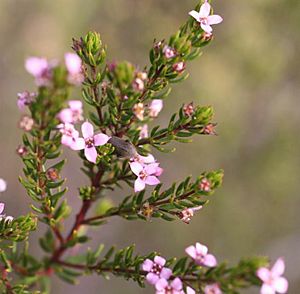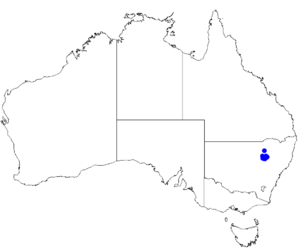Boronia warrumbunglensis facts for kids
Quick facts for kids Boronia warrumbunglensis |
|
|---|---|
 |
|
| Boronia warrumbunglensis in the Pilliga forest | |
| Scientific classification | |
 |
|
| Occurrence data from Australasian Virtual Herbarium |
Boronia warrumbunglensis is a special plant that belongs to the citrus family, called Rutaceae. It's found only in a small part of central-west New South Wales, Australia. This plant is a shrub with many branches. It has leaves that look like feathers (called pinnate leaves).
You'll also see one or two pretty pink flowers with four petals growing where the leaves meet the stem. This type of boronia is only found in the Warrumbungles area and nearby places.
What Does It Look Like?
Boronia warrumbunglensis is a shrub that usually grows between 0.3 and 1 meter (about 1 to 3 feet) tall. It has many branches that are covered in fine hairs.
Its leaves are "pinnate," meaning they have smaller leaflets arranged along a central stem, like a feather. Each leaf has three, five, or seven leaflets. The whole leaf can be from 6 to 32 mm (about 0.2 to 1.3 inches) long and 2 to 27 mm (about 0.08 to 1.1 inches) wide. The stem that holds the leaf (called a petiole) is about 3 to 6 mm (0.1 to 0.2 inches) long.
The small leaflets themselves are shaped like an oval or a spearhead. They are about 5 to 16 mm (0.2 to 0.6 inches) long and 1.5 to 3 mm (0.06 to 0.1 inches) wide.
Flowers and Fruit
The flowers of Boronia warrumbunglensis are pale to bright pink. They grow either one by one or in pairs where the leaves join the stem. Each flower sits on a small stalk called a pedicel, which is about 3 to 7 mm (0.1 to 0.3 inches) long.
Each flower has four sepals, which are like small, leaf-like parts that protect the flower bud. These sepals are triangular or egg-shaped, about 2.5 to 3.5 mm (0.10 to 0.14 inches) long and 1.5 to 2 mm (0.06 to 0.08 inches) wide. They are quite hairy on their underside.
The four pink petals are about 5 to 6 mm (0.20 to 0.24 inches) long and 2.5 to 3 mm (0.10 to 0.12 inches) wide. Interestingly, these petals get bigger as the fruit starts to grow.
Inside the flower, there are eight stamens, which are the parts that produce pollen. They are different lengths, with some being longer than others. This plant usually flowers from August to October. After flowering, it produces a hairy fruit called a capsule, which is about 5 to 6 mm (0.20 to 0.24 inches) long and 3 to 3.5 mm (0.12 to 0.14 inches) wide.
How It Got Its Name
The plant Boronia warrumbunglensis was officially described for the first time in 1990. This description was made by a botanist named Peter H. Weston and was published in a scientific journal called Telopea.
The second part of its scientific name, warrumbunglensis, tells us where this plant is found. The ending -ensis is a Latin suffix that means "from a place" or "belonging to a locality." So, warrumbunglensis means "from the Warrumbungles," which is where this boronia mostly grows.
Where Does It Live?
This special boronia plant grows in forests on sandstone soil. You can find it in the Warrumbungles area and around the Coonabarabran district in New South Wales, Australia.

